Three-generation (or 3G) synthetic pitches are a step up from older styles of artificial turf, which were primarily filled with sand. These pitches can still be used for lower-level hockey and achieve FIH National performance standards. In addition, Category 2 England Hockey Pitches are designed to meet the specifications of World Cup and Olympic competitions. The 3G synthetic pitch is able to perform to these standards because it contains a mixture of grass-like fibres and rubber granules.
However, synthetic pitches pose a number of challenges. For one thing, they get really hot during summer. Because grass absorbs energy from the sun, it keeps the surrounding air cool. Synthetic pitches, on the other hand, tend to be 40degC hotter than natural fields. In addition, these pitches contribute to the urban heat island effect, which increases local air temperature by 4 degrees Celsius. This is especially problematic since many sporting grounds allow dogs to be walked on leashes.
The synthetic pitch allows clubs to create a sense of community for their members. Youth teams could practice on the same pitch as the first team, which meant that they could see their peers from other age groups. And with a large number of teams, synthetic pitches create an environment where all age groups can be represented. They also encourage greater teamwork between different groups. If you are a member of a club or a local community, you can become involved in the discussion by donating a synthetic pitch.
While grass pitch replacement is environmentally friendly, the disposal and recycling of synthetic pitches poses significant challenges. Because synthetic pitches are made from synthetic fibres from the petrochemical industry, they have a negative carbon footprint and high recycling costs after 10 years. Moreover, some scientific research suggests that playing on synthetic pitches can increase the risk of injury. However, the scientific studies are largely contradictory. For example, the “rubber infill” that most synthetic pitches are made from is sourced from car tyre residues.
In addition to the benefits of artificial turf for players, synthetic pitches also create a sense of community among fans. Unlike natural grass, the synthetic turf is able to withstand more hours of use without deteriorating. Furthermore, the artificial turf also allows for more community programmes and initiatives. The research is based on interviews with participants from various sports clubs in Scotland. The study findings will help identify how to best apply these findings to create the perfect playing surface for the sport of your choice.
Synthetic pitches are often known by several names, depending on their construction technology and sport. The process of making synthetic grass is similar to that of manufacturing carpets. Infill materials are used to mimic the bounce characteristics of natural grass pitches. However, these materials may be a mixture of sand and rubber or they could be another material. In some cases, these artificial pitches do not use infill materials, while others do. A few top-level sports such as soccer, football, and hockey use a non-fill water-based pitch for their competitions.
Read More Articles : Synthetic Cricket Pitch
Suggested Post : Lawn Moving Mowers – Find the Best Price For the Most Efficient Use
Recent Post : Lawn Moving Equipment

